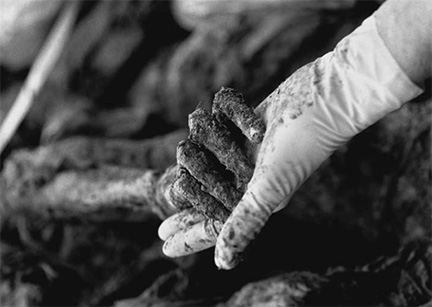
A mass grave near Zvornik from which more than 500 corpses were exhumed, 2002; photograph by Tarek Samarah
In a recent open access article, The Science of Hatred, in The Chronicle of Higher Education, Tom Bartlet discusses a psychologist attempting to understand the Serbian denial of the massacres of Muslims in Bosnia in the 1990s. The subtitle is: “What makes humans capable of horrific violence? Why do we deny atrocities in the face of overwhelming evidence? A small group of psychologists say they are moving toward answers. Is anyone listening?” The article is more a profile of Sabina Cehajic-Clancy, a Bosnian social psychologist who studies intergroup conflict, than a probing of the title. The focus is more on “how” Serbs could deny such a well documented atrocity rather than the motivations for the mass killing. There really is no “science” in the article, a part from a nod to some role for our evolutionary trajectory. But if you would like to read a human-interest story about an individual working on a very personal matter to better understand the denial of atrocities, it is worth reading.
The idea that there can be a “science” of hatred sounds promising, but it tends to fall apart less over the debate about what science is than what we mean by the emotionally charged notion of “hatred.” Several religions teach the God is love, but then also note that there are lots of things that God hates. Love and hate go together, not so much as polar opposites but as part of a continuum of how we perceive the world around us as comforting and dangerous at the same time. There is one kind of hate or love that is directed to an individual because of the familiarity of interaction. Falling into love, to quote the romantic rubric, suggests that we can fall into hate as well. But these are metaphors that swirl around fuzzy concepts. In the Bosnian case, it was a hatred, to use the fuzzy term, of a racial/ethnic/religious category that was hated, not the result of any specific action that any of the individuals did. And, as the egregious amount of war-based rape attests, the freezing of Bosnian Muslim women into a distinct racial category justified diluting their “pure” blood with Serbian Christian semen. And the perverse vice was used by some Bosnians in retaliation against Serbs, although to a much lesser extent.
There is a danger in assuming that science can explain ethics; that danger is a reductionism that echoes the kind of pseudo-science or racial purity that Serbs used to justify (as though they actually cared about justification) rape and mass slaughter. The fools-gold notion of James Frazer that human ethics have evolved from magic to religion to science fails to understand what makes the scientific method different from these other paradigms, which remain in force and often with more acceptance. There is no science of hatred because hatred is not a scientific concept; for the same reason there is no science of God. The scientific method can be and should be applied to studying behavior of humans and out near ancestors that we bundle into fuzzy concepts like hatred (or love), but the value of the method is in proposing hypotheses that are backed up by specific kinds of evidence that can be assessed, debated and even contested.
The mass killings in Bosnia, or in Congo or in Syria or in just about any spot on the earth can in theory all be reduced to a fuzzy notion like “hate” but there is no scientific value in doing so. Humans interact with each other in unique social and cultural contexts. There are indeed biological predispositions, but “hatred” is not conceived in the womb. To best understand the why of mass murder or genocide and then denial of either the fact or the responsibility requires an approach that is scientific in the way that questions are formed, but artful in the way that they are interpreted.